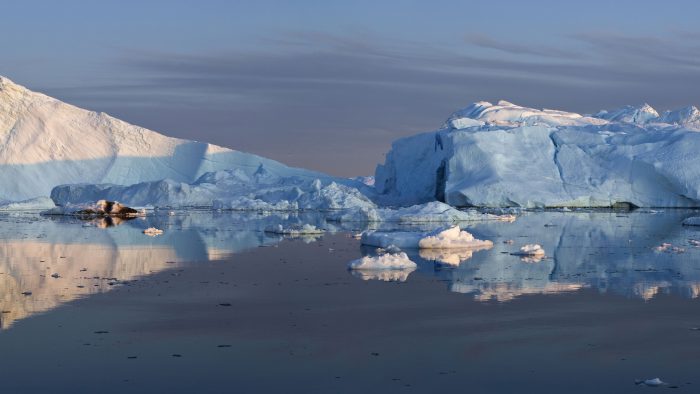 Natural Sciences
Natural Sciences
A Rising Tide

As Greenland goes, so go the waters of the world.
Most of the country is covered in a layer of ice two miles thick. This is the Greenland ice sheet, and as it melts it is contributing as much as one-quarter of global sea level rise. The loss of two of the ice sheet’s biggest glaciers, in fact, would raise the world’s seas by more than three feet.
Over the last 40 years, the melting rate of the ice sheet has increased four-fold. That’s largely due to the planet’s warming atmosphere, but it appears that oceans play a bigger role than previously realized—a discovery owing in part to the work of two UO scientists.
David Sutherland, an earth sciences professor, studies the impact of oceans on glaciers, and vice versa. He was recently part of a team that made a major breakthrough in the relationship between the two in Greenland.
Much of the Greenland ice sheet ends in “tidewater glaciers”—glaciers that extend into fjords, narrow inlets of deep water that connect to the Arctic and Atlantic oceans.
Scientists suspected that warmer ocean waters were melting the underside of the ice. But before the work by Sutherland’s team, they had little proof in terms of either measurements of glaciers or neighboring ocean temperatures.
Sutherland and researchers from Oregon State University examined the inlets over an extended period, from fall 2013 to summer 2015.
They found large and rapid swings in the temperature and salinity of the water. Driven by winds and ocean movements, fast-moving currents replaced old water with new every few days. Meanwhile, water temperatures close to the glaciers fluctuated greatly, by as much as 5 degrees Celsius in a day.
This told the team that natural forces systematically pumped new water into the fjord, which meant that any changes in ocean temperatures outside the inlet would be quickly transferred right to the glacier.
That opens up important questions that scientists like Sutherland are just beginning to explore. Is there a direct relationship between the melt rate of glaciers and water temperatures there? Do melt rates change dramatically, given the rapid changes in the water itself?
“The ultimate motivation of all this fjord and glacier work is to improve predictions of global sea level rise,” said Sutherland, whose projects are funded by grants from the National Science Foundation totaling $1.3 million.
Because they’re partially submerged, tidewater glaciers present an uncommon challenge for scientists seeking to take measurements. Their vertical faces are largely inaccessible and massive hunks of ice can slough off without warning, keeping researchers at a distance.
To get up-close-and-personal, Sutherland and his colleagues take measurements with remote-controlled boats. They use remote cameras to shoot time-lapse photos of glacial changes and sonar to map out what’s happening to the ice underwater.
And what’s happening underwater is troubling, according to Dustin Carroll, a doctoral student in earth sciences who is mentored by Sutherland.

Sutherland is also studying icebergs off the coast of Greenland because they affect circulation in the world’s oceans and that, in turn, affects climate.
As glaciers melt, water collects atop them in frigid lakes of millions of gallons. That water eventually drains through the ice, sometimes in a sudden, violent rush.
For tidewater glaciers, this draining is especially damaging because the ice is partially submerged in the inlet. When the water drains, it exits into the seawater under the ice.
This begins a process, which as Carroll described for a story in The Washington Post, is similar to the way a plume of smoke rises from a chimney and expands; it expands because it’s drawing in warmer air.
Likewise, once the glacial runoff rushes into the sea, it creates an underwater plume that rises and expands, pulling in warmer ocean water. That warmer plume erodes the glacier’s base, sending huge chunks of ice toppling off.
It’s also the beginning of a vicious cycle, Carroll says. As more of the Greenland ice sheet melts, more water will drain out of the glaciers, generating bigger plumes that draw in more ocean water that do more damage.
Sea level rise is just one concern. The interplay of oceans and ice in Greenland is actually changing the nature of the North Atlantic.
Said Sutherland: “That will mean changes not just for local marine ecosystems, but the global climate.”
—Jim Murez
Photo credit: Rosemary Camozzi


 Twitter
Twitter Facebook
Facebook Forward
Forward